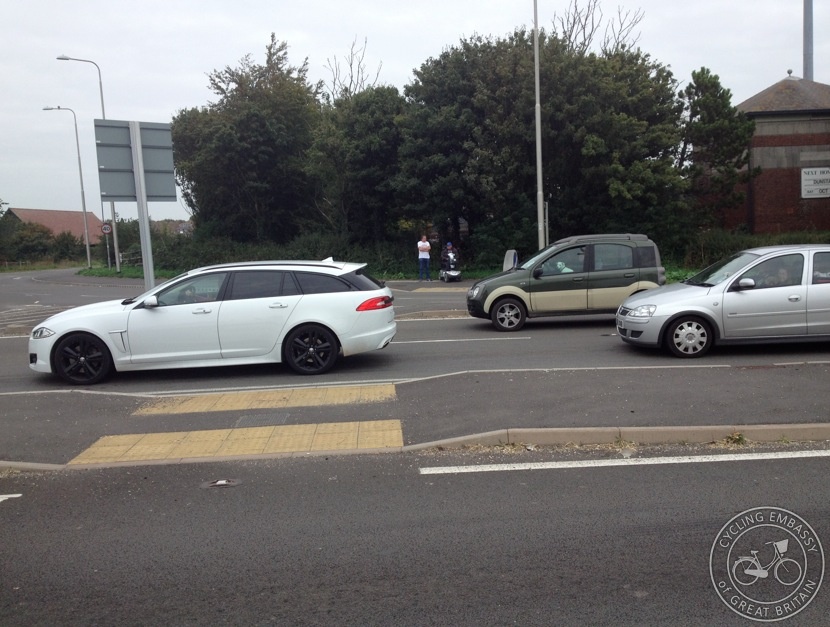A Dorset Safari - how leadership is needed from the Department for Transport
At the end of September, the Embassy was invited down to Dorset by the county's Principal Transport Planner, to take a look at what Dorchester and Weymouth have achieved with (limited) amounts of funding, and in the face of political opposition to designing for cycling - our latest in a series of Infrastructure Safaris.
Despite the good routes that have been implemented in the area, we found significant barriers to further progress. These took the form of lack of funding, obstructiveness from national bodies, and an absence of decent design standards. We were also told about political opposition, and ignorance about good practice, at a local level. These are problems that will hamper progress, even in areas where planners are willing, keen and enthusiastic to create attractive conditions for cycling. And most of these barriers need to be dealt with by central government, in the form of adequate funding streams, and proper design guidance.
Some of these problems were immediately apparent as we left Dorchester. A lack of funding meant that, despite plenty of space being available, the route towards Weymouth took the form of a (converted) shared footway, rather than a fully separated cycle track. In one location, this route passes right through a bus stop.
This road then meets the Dorchester bypass, where a roundabout (built by the Highways Agency) has to be negotiated.

This involves three separate 'informal' crossings of heavy traffic, travelling at some speed around the bypass and the roundabout itself. Having (just about) managed to use these crossings ourselves, we stood for several minutes watching a man on a mobility scooter (above) totally unable to cross this roundabout safely.
This Highways Agency roundabout should plainly have involved a grade-separated crossing for walking and cycling from the outset; these crossings, however, are all that were provided. (We were told that even signs warning drivers of the potential presence of people crossing were rejected by the Highways Agency on the grounds that they would be too distracting). So this (new!) roundabout represents a major barrier to walking and cycling between Dorchester and the environment to the south of the town. Obstacles are being put in the way, when joined-up policy could open up opportunities for other modes.
The route between Dorchester and Weymouth is, for the most part, of a good quality, increasingly set back from the road itself the further away from Dorchester we travelled, and with a reasonably wide and smooth surface.
There are, however, problems with the side road treatments, which all lack continuity and priority, at junctions with minor lanes, and even farm entrances.
This is presumably the result of a lack of confidence on the part of the designers, and also due to a lack of clear standards on how cycling provision can and should be given priority in these sorts of situations.
Indeed, a general theme of much of the infrastructure between (and in) the two towns was that it is pedestrian-specific, but designed to accommodate (reasonably low) flows of cycling. The roundabouts on the outskirts of Weymouth were a typical example.
These crossings are poorly suited for cycling. The angles of entry and exit are poor, the islands are not wide enough to safely accommodate a waiting cyclist, and the tactile paving is uncomfortable. They are designed for walking, not for cycling.
Much of the blame for this kind of design must lie with the Department for Transport, who do not have a manual that advises on cycle-specific design at roundabouts. Without that kind of instruction, it's not surprising that local authorities continue to bodge cycling into walking designs, as best as they can.
Similarly, a good quality shared path in Weymouth itself was let down by ambiguous side road crossings.
Here, again, little concession has been made to cycle-specific design. Note in particular the absence of 'Give Way' markings, either on the path, or on the road. We were told that the local authority believes that tactiles function as 'Give Way' markings, which is worrying, to say the least.
It is details like this that show the desperate need for leadership in high-quality cycling design, from the Department for Transport itself. Local authorities are interpreting ambiguous shared 'walking and cycling' design in potentially dangerous ways, because there is no guidance explicitly telling them how to build good-quality cycle-specific provision.
Older routes in Weymouth are clearly substandard, dating from a period where even less money was available, and there was presumably less willingess to do things to a higher standard.
To their credit, much of the stuff that Weymouth is building now is of a good standard, actually connects up, and is (unsurprisingly) well-used.
They are even counting the numbers of people cycling on these routes, with permanent counters, to measure their own progress.
Obstacles remain in the centre of Weymouth - many of the streets are (unnecessarily) clogged with parked cars, and with drivers endlessly circulating around to find parking spaces.

This is something the planners are attempting to resolve, by removing some of this parking, and creating more public space on the waterfront (a trial of this was underway on the day we visited).
The overall impression we received was of a local authority attempting to do as much as they can, as well as they can, but hampered by limited funding, and a lack of clear design standards, which means they are often improvising, or that their plans are open to interpretation by officers, in less than helpful ways.
Levels of cycling in Weymouth have grown substantially on the new routes that have been built, so there is a clear case for doing more, and for doing it better - and not just in Weymouth, across the rest of Britain. Will central government start helping?
We've previously been on Safari to Dorchester and Weymouth with Joe Dunckley - you can read his report here
